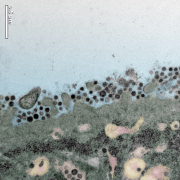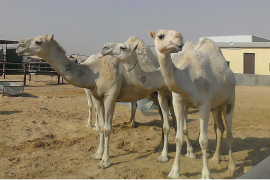Media
HKU and international research teams find that
Middle East respiratory syndrome coronavirus (MERS-CoV)
from dromedary camels in different regions can infect humans
29 Aug 2014
An international research team, led by Professor Malik Peiris, Chair Professor of Virology and Director of School of Public Health, Li Ka Shing Faculty of Medicine, The University of Hong Kong (HKU), in collaboration with the College of Veterinary Medicine, King Faisal University, Saudi Arabia, National Research Centre, Giza, Egypt and St Jude Children’s Research Hospital, Memphis, United States of America (USA), have found that the Middle East respiratory syndrome coronavirus (MERS-CoV) found in dromedary camels in Saudi Arabia and in Egypt efficiently infects cultures of the human respiratory tract tissues. The research has been published today in the international scientific journal, Lancet Respiratory Medicine.
Research Implications
Professor Malik Peiris, Tam Wah-Ching Professor in Medical Science, Chair Professor of Virology and Director of School of Public Health, Li Ka Shing Faculty of Medicine, HKU, says, “Genetically diverse MERS-CoV from dromedary camels in Saudi Arabia and Egypt were very similar to MERS-CoV from humans. Most importantly, both human and camel viruses can efficiently infect tissues of human respiratory tract. This suggests that viruses from camels can infect humans. Our findings further suggest that the transmission of MERS-CoV from camels to humans might not only be restricted to the Arabian peninsula (from where primary human MERS cases have so far being detected), but might also be found in parts of Africa.”
Professor John Nicholls, Clinical Professor of Department of Pathology says, “The methods for culturing human respiratory tissues that were perfected by HKU researchers now allows us to risk-assess the capacity of an animal virus to infect humans.”
This is the most comprehensive biological characterisation of MERS-CoV from camels carried out to date. The findings suggest the need for enhanced surveillance of humans with severe respiratory disease for MERS should be extended beyond the Arabian peninsula to include parts of Northern and Eastern Africa. It also highlights the need for more studies to map the full geographic range of MERS-CoV infections in camels. And studies to identify how MERS-CoV is transmitted from camels to humans are also needed. Tourists who go to the Middle East and Northeast Africa should be reminded to avoid camel contact and of maintaining good personal hygiene when coming in contact with camels. Camel MERS-CoV is mainly found in the mouth and saliva of the animals but can also be found in camel feces.
Study method and findings
Two camel MERS-CoVs from Saudi Arabia and one camel MERS-CoV from Egypt were compared with a human MERS-CoV isolated in Saudi Arabia for their ability to infect and replicate in human respiratory tissues maintained in experimental settings. It was observed that both animal and human viruses can infect the same cell types in human bronchial and lung tissues with comparable virus replication kinetics. These findings suggest that camel MERS-CoV has potential to infect humans. MERS-CoV was previously known to evade the human first-line immune defense system (e.g. interferons). The current study shows that camel MERS-CoV might also have the capacity to by-pass these first-line defense mechanisms in humans.
Background
MERS is a severe pneumonic illness caused by a novel coronavirus. From April 2012 to July 23, 2014, there have been 837 confirmed human MERS cases leading to 291 deaths reported to WHO. So far all the primary human cases originated from countries within the Arabian Peninsula. The human virus is believed to be of zoonotic origin but some limited human-to-human transmission has taken place. MERS-CoV is found in dromedary camels (Camelus dromedaries) which are the one-humped camels typically found in the Middle East and Northeast Africa as contrasted with Bactrian or two-humped camels (Camelus bactrianus) which inhabit Central Asia. However, the number of MERS-CoV isolates from camels is limited and so far there has been no systematic biological characterisation of these camel viruses.
About the research team
This research was led by Professor Malik Peiris, Tam Wah-Ching Professor in Medical Science, Chair Professor of Virology and Director of School of Public Health, Li Ka Shing Faculty of Medicine, HKU. Major team members in this study include: Professor John Nicholls, Clinical Professor of Department of Pathology, Dr Renee Chan, Research Assistant Professor, Dr Leo Poon, Associate Professor and Professor Yi Guan, Daniel CK Yu Professor in Virology of School of Public Health, Li Ka Shing Faculty of Medicine, HKU. The international research team includes Dr Maged Hemida at the King Faisal University, Saudi Arabia, Dr Ghazi Kayali at St Jude Children’s Research Hospital, Memphis, USA and Dr Mohammad Ali at the National Research Centre, Giza, Egypt.
This research was funded by the Health and Medical Research Fund (Ref: 13121132), Research Fund Secretariat, Food and Health Bureau, Hong Kong Special Administrative Region, the National Institute of Allergy and Infectious Diseases (NIAID) contract HHSN272201400006C and the European Community Seventh Framework Program (FP7/2007-2013) (EMPERIE).
Please visit the website at http://www.med.hku.hk/v1/news-and-events/press-releases/ for press photos.
An electron microscope picture shows that the cells from human bronchial tissue can be infected by MERS-CoV and the MERS-CoV can replicate in human respiratory tissues.


